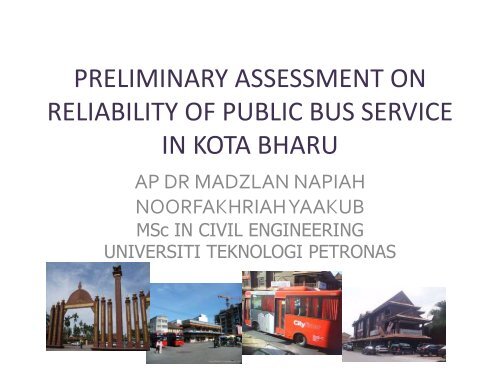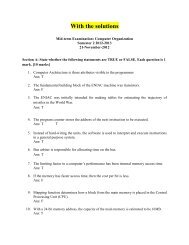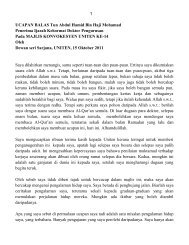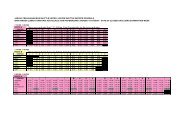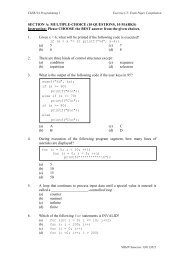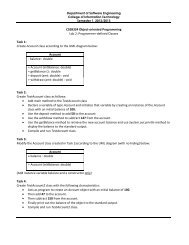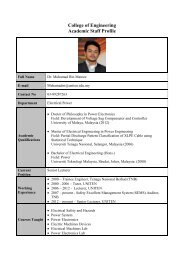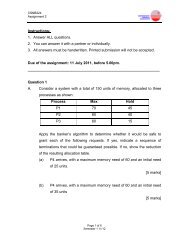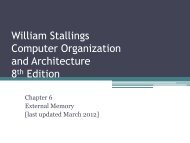preliminary assessment on reliability of public bus service in kota ...
preliminary assessment on reliability of public bus service in kota ...
preliminary assessment on reliability of public bus service in kota ...
Create successful ePaper yourself
Turn your PDF publications into a flip-book with our unique Google optimized e-Paper software.
PRELIMINARY ASSESSMENT ON<br />
RELIABILITY OF PUBLIC BUS SERVICE<br />
IN KOTA BHARU<br />
AP DR MADZLAN NAPIAH<br />
NOORFAKHRIAH YAAKUB<br />
MSc IN CIVIL ENGINEERING<br />
UNIVERSITI TEKNOLOGI PETRONAS
OUTLINE<br />
• Introducti<strong>on</strong><br />
• Literature Review<br />
• Methodology<br />
• Progress<br />
• Future Directi<strong>on</strong><br />
• Reference
Introducti<strong>on</strong><br />
• Travell<strong>in</strong>g trips needed are <strong>in</strong>creased to comply with<br />
the <strong>in</strong>crease <strong>in</strong> ec<strong>on</strong>omic activities and rapid growth <strong>of</strong><br />
urbanizati<strong>on</strong>.<br />
• Many possess their own vehicle for access<strong>in</strong>g the<br />
urban <strong>service</strong>, which before l<strong>on</strong>g result<strong>in</strong>g <strong>in</strong> traffic<br />
c<strong>on</strong>gesti<strong>on</strong>.<br />
• Citizen has to pay fuel and toll price <strong>in</strong> order to move<br />
from <strong>on</strong>e place to another, therefore a cheaper<br />
alternative should be enhanced.<br />
• The use <strong>of</strong> <strong>public</strong> <strong>bus</strong> can reduce traffic c<strong>on</strong>gesti<strong>on</strong>,<br />
save m<strong>on</strong>ey and time, and less polluti<strong>on</strong> emissi<strong>on</strong>
Introducti<strong>on</strong><br />
Problem Statement<br />
• “Transport <strong>in</strong>frastructure <strong>in</strong> the country is ready<br />
to meet the needs <strong>of</strong> the 21 st century<br />
expectati<strong>on</strong>” – The Government<br />
• “Public <strong>bus</strong> <strong>service</strong> is satisfactory”<br />
– The <strong>bus</strong> operator<br />
• “Frustrated with present situati<strong>on</strong> <strong>of</strong> <strong>public</strong> <strong>bus</strong><br />
system <strong>in</strong> Malaysia”<br />
– The <strong>public</strong>
Introducti<strong>on</strong><br />
Objectives <strong>of</strong> Study<br />
(c<strong>on</strong>ceptual framework and <str<strong>on</strong>g>prelim<strong>in</strong>ary</str<strong>on</strong>g> survey)<br />
• To determ<strong>in</strong>e the PI<br />
• To determ<strong>in</strong>e user comfort and problems<br />
• To c<strong>on</strong>clude the state <strong>of</strong> <strong>reliability</strong><br />
• To recommend soluti<strong>on</strong>s for aris<strong>in</strong>g problems<br />
• To advise new route or necessary schedule
Scope (Limitati<strong>on</strong>)<br />
• C<strong>on</strong>ducted <strong>in</strong> Kota Bharu<br />
• C<strong>on</strong>ducted for city <strong>bus</strong>es <strong>on</strong>ly (6 routes)<br />
• Us<strong>in</strong>g <strong>on</strong> board method (can determ<strong>in</strong>e<br />
reas<strong>on</strong> for delayed or missed trips)<br />
• One week data for each route
Literature Review<br />
• Current state <strong>of</strong> Malaysia’s <strong>public</strong> transport<br />
especially <strong>public</strong> <strong>bus</strong> is perceived <strong>of</strong> unable to<br />
meet citizen’s needs satisfactorily. Many claim<br />
that if the <strong>public</strong> transport is be<strong>in</strong>g improved,<br />
they are will<strong>in</strong>g to use it <strong>in</strong>stead <strong>of</strong> pay<strong>in</strong>g for<br />
outrageous petrol prices and tolls and end<strong>in</strong>g<br />
up stuck <strong>in</strong> traffic jams<br />
(Kambala, 2007).
Literature Review<br />
• Government Transportati<strong>on</strong> Programme (GTP)<br />
is <strong>in</strong>troduced <strong>in</strong> 2009<br />
Figure 1: The percentage (modal share) <strong>of</strong> <strong>public</strong> transport user <strong>in</strong> Klang Valley by year. Broken<br />
l<strong>in</strong>e <strong>in</strong>dicates the target to be achieved by end <strong>of</strong> 2010 (13%) and 2012(25%).
Literature Review<br />
• Kota Bharu, capital city <strong>of</strong> Kelantan expands<br />
403km 2 with 500 000 populati<strong>on</strong> (Statistics,<br />
2010)<br />
Figure 2: Kota Bharu as the capital<br />
city <strong>of</strong> Kelantan state (Department<br />
<strong>of</strong> Survey and Mapp<strong>in</strong>g Malaysia<br />
JUPEM, 2005)
Literature Review<br />
• Reliability <strong>of</strong> transportati<strong>on</strong> system can be<br />
def<strong>in</strong>ed as the ability <strong>of</strong> the system to adhere to a<br />
schedule or ma<strong>in</strong>ta<strong>in</strong> regular headways and a<br />
c<strong>on</strong>sistent travel time; <strong>in</strong> other words, as the <strong>on</strong>time/punctuality<br />
performance and headway<br />
evenness (Chen, 2009)<br />
• For Malaysian M<strong>in</strong>istry <strong>of</strong> Transportati<strong>on</strong>, the<br />
<strong>reliability</strong> <strong>of</strong> <strong>public</strong> transport is def<strong>in</strong>ed as the<br />
percentage <strong>of</strong> journey times completed with<strong>in</strong> 60<br />
m<strong>in</strong>utes dur<strong>in</strong>g the morn<strong>in</strong>g peak period (GTP<br />
Roadmap, 2010).
Literature Review<br />
• Factors affect<strong>in</strong>g <strong>reliability</strong>:<br />
• 1. Traffic Characteristics<br />
• 2. Route Characteristics<br />
• 3. Passenger Characteristics<br />
• 4. Bus Operati<strong>on</strong>al Characteristics<br />
(Liu, 2008)
Literature Review<br />
• In this paper, the Punctuality Index <strong>of</strong> a <strong>bus</strong><br />
<strong>service</strong> is a factor <strong>in</strong>dicat<strong>in</strong>g the time gap<br />
between scheduled and actual arriv<strong>in</strong>g and<br />
depart<strong>in</strong>g time for a <strong>bus</strong>, or also called the<br />
headway adherence.<br />
• The Traffic Capacity and Quality <strong>of</strong> Service<br />
Manual (TCQSM, 2003) suggests that both<br />
OTP and headway adherence can be used as a<br />
measure <strong>in</strong> <strong>reliability</strong> <strong>in</strong>dicati<strong>on</strong>.
Literature Review<br />
• Kho (2005) suggested formulati<strong>on</strong> used for PI:<br />
S<br />
2<br />
P is Punctuality Index<br />
h is scheduled headway<br />
P<br />
…(1)<br />
S is variable<br />
h<br />
S<br />
2 1<br />
I<br />
i<br />
I<br />
1<br />
t i<br />
i<br />
2<br />
…(2)<br />
I is no. <strong>of</strong> operati<strong>on</strong>s<br />
t is actual arrival time<br />
τ is scheduled arrival time
Methodology<br />
• On Board Method<br />
-Surveyor ride <strong>on</strong> <strong>bus</strong>es<br />
-Off board method will record more <strong>bus</strong> trips per<br />
period <strong>of</strong> time compared to <strong>on</strong> board but us<strong>in</strong>g<br />
<strong>on</strong> board method, the surveyor can observe the<br />
passenger pr<strong>of</strong>ile and reas<strong>on</strong>s <strong>of</strong> delay.<br />
-The required data are: <strong>bus</strong> schedule, number <strong>of</strong><br />
trips, frequency, distance to each stops, actual<br />
arrival and departure time at stati<strong>on</strong>s and stops.
Methodology<br />
• Questi<strong>on</strong>naires<br />
-Questi<strong>on</strong>naires are distributed to get<br />
passengers view <strong>of</strong> the <strong>public</strong> <strong>bus</strong> <strong>service</strong> <strong>in</strong><br />
Kota Bharu and their expectati<strong>on</strong>.<br />
• Handheld GPS to determ<strong>in</strong>e distance<br />
-Garm<strong>in</strong> s<strong>of</strong>tware is used to determ<strong>in</strong>e the<br />
exact distance <strong>of</strong> each route.
Progress<br />
• Two <strong>bus</strong> stati<strong>on</strong> to cater for city <strong>bus</strong>es, located<br />
about 200m from each stati<strong>on</strong>s.<br />
Table 1: Bus routes <strong>in</strong> Kota Bharu<br />
No. Stati<strong>on</strong> Trip ID Bus Route Route Type<br />
1<br />
4 Kota Bharu - Kompleks Sekolah - Padang Tembak Direct<br />
2 Hilir Pasar 8 Kota Bharu - Kemum<strong>in</strong> - Sabak Direct<br />
3 9 Kota Bharu - Pengkalan Chepa - Sabak Direct<br />
4<br />
10 Kota Bharu - Penambang - Pantai Cahaya Bulan Direct<br />
5 Buluh Kubu 61A Kota Bharu - Kubang Kerian - Pasir Hor - Kg. Sireh Loop<br />
6 61B Kota Bharu - Kg. Sireh - Pasir Hor - Kubang Kerian Loop
Progress<br />
• City <strong>bus</strong> route <strong>in</strong> Kota Bharu<br />
Figure 6: Kota Bharu e- map (JUPEM, 2004) with the city <strong>bus</strong> routes.
Progress<br />
The Passenger<br />
• Compla<strong>in</strong>ed <strong>bus</strong>es always late<br />
• L<strong>on</strong>g wait<strong>in</strong>g time<br />
• Some route have fewer <strong>bus</strong> allocati<strong>on</strong><br />
• Is shift<strong>in</strong>g to other modes <strong>of</strong> tansportati<strong>on</strong><br />
The Schedule<br />
• Bus depart accord<strong>in</strong>g to schedule, however<br />
headway is big due to <strong>bus</strong> shortage<br />
• Causes <strong>of</strong> delay: heavy traffic, school children
Progress<br />
The Driver<br />
• Some drivers depart earlier than schedule,<br />
caus<strong>in</strong>g headway too big.<br />
• Some passengers can’t afford to wait too l<strong>on</strong>g.<br />
• Mak<strong>in</strong>g <strong>public</strong> <strong>bus</strong> unattractive <strong>in</strong> the l<strong>on</strong>g run<br />
The Bus C<strong>on</strong>diti<strong>on</strong><br />
• Grade B (27 seats, 7 stand<strong>in</strong>g)<br />
• Comfortable, air-c<strong>on</strong>diti<strong>on</strong>ed, two automated<br />
doors<br />
• Ec<strong>on</strong>omical ticket<strong>in</strong>g system
Progress<br />
The Company<br />
• Cityl<strong>in</strong>er, the <strong>on</strong>ly <strong>public</strong> <strong>bus</strong> operator for<br />
Kelantan state<br />
• Citizen totally rely <strong>on</strong> the <strong>service</strong><br />
• The company is <strong>in</strong> progress <strong>of</strong> buy<strong>in</strong>g more<br />
<strong>bus</strong>es to satisfy user’s demand
Future Directi<strong>on</strong><br />
• This paper is a part <strong>of</strong> an <strong>on</strong>go<strong>in</strong>g research whereby <strong>on</strong>ly the<br />
c<strong>on</strong>ceptual framework is presented.<br />
• This study is focused <strong>on</strong> determ<strong>in</strong><strong>in</strong>g the <strong>reliability</strong> <strong>of</strong> <strong>public</strong><br />
<strong>bus</strong> <strong>on</strong> Kota Bharu <strong>in</strong> terms <strong>of</strong> Punctuality Index analysis.<br />
• The expected outcome will be the analysis <strong>of</strong> data gathered<br />
dur<strong>in</strong>g survey which will determ<strong>in</strong>e the <strong>reliability</strong> and<br />
performance <strong>of</strong> the <strong>bus</strong> <strong>service</strong>.<br />
• From the analysis, discussi<strong>on</strong> and <strong>in</strong>ference can be carried out<br />
to enhance this study, then recommendati<strong>on</strong> can be advised<br />
to improve the <strong>service</strong> or <strong>in</strong>troduce new feasible route.<br />
• Such studies should be c<strong>on</strong>ducted <strong>in</strong> other places to improve<br />
the <strong>public</strong> <strong>bus</strong> <strong>service</strong> <strong>in</strong> many parts <strong>of</strong> Malaysia. Thus the<br />
people will have more opti<strong>on</strong> for better transportati<strong>on</strong>.
Reference<br />
• Abdalla Nurdeen Kambala, Riza Atiq, O.K. Rahmat, Amirudd<strong>in</strong> Ismail. (2007). Why Do People Use Their Cars: A Case Study In<br />
Malaysia. Journal <strong>of</strong> Social Sciences 3 (3): 117 – 122.<br />
• Basic Populati<strong>on</strong> Characteristics by Adm<strong>in</strong>istrative Districts June 2010. (2010). Department <strong>of</strong> Statistics.<br />
• Malaysia. Retrieved from http://www.statistics.gov.my/~Itemid=53&lang=en/<br />
• Carlos Gershens<strong>on</strong>, Luis A. P<strong>in</strong>eda. (2009). Why Does Public Transport Not Arrive <strong>on</strong> Time? The<br />
• Pervasiveness <strong>of</strong> Equal Headway Instability. Plos One open access, Vol. 4, Issue 10.<br />
• E-Map, Kelantan Electr<strong>on</strong>ic Map. (2004). Department <strong>of</strong> Survey and Mapp<strong>in</strong>g (JUPEM). Kelantan,<br />
• Malaysia.<br />
• Government Tranportati<strong>on</strong> Programme – Roadmap. (2010). Land Public Transport Commissi<strong>on</strong> (SPAD). Retrieved from<br />
http://www.pemandu.gov.my/~gid=41&lang=en/<br />
• Jamilah Mohamad dan Nik Ibtisamiah Ibrahim. (2005). Characteristics <strong>of</strong> Bus Service Provisi<strong>on</strong> <strong>in</strong> Kota<br />
• Bharu, Kelantan. Journal <strong>of</strong> Transportati<strong>on</strong> Science Society <strong>of</strong> Malaysia 1 13-25.<br />
• John Bates. (2009). An Agenda for Research <strong>on</strong> Reliability. Associati<strong>on</strong> for European Transport and<br />
• C<strong>on</strong>tributors.<br />
• Margareta Friman. (2004). Implement<strong>in</strong>g Quality Improvement <strong>in</strong> Public Transport. Journal <strong>of</strong> Public<br />
• Transportati<strong>on</strong>. Vol. 7, No. 4.<br />
• Nicholas J. Garber & Lester A. Hoel (2002). Traffic and Highway Eng<strong>in</strong>eer<strong>in</strong>g, 3 rd Editi<strong>on</strong>. Tor<strong>on</strong>to, Canada. Thoms<strong>on</strong> Learn<strong>in</strong>g. p. 571.<br />
• R<strong>on</strong>ghui Liu and Shal<strong>in</strong>i S<strong>in</strong>ha. (2008). Modell<strong>in</strong>g Urban Bus Service and Passenger Reliability.<br />
• Seung-Young Kho, Jun-Sik Park, Young-Ho Kim, Eun-Ho Kim. (2005). A Development <strong>of</strong> Punctuality<br />
• Index for Bus Operati<strong>on</strong>. Journal <strong>of</strong> the eastern Asia Society for Transportati<strong>on</strong> Studies. Vol. 6.<br />
• p 492 – 504.<br />
• Transit Capacity and Quality <strong>of</strong> Service Manual. (2003). 2 nd Editi<strong>on</strong>. Retrieved from<br />
• http://trb.org/~/part%201.pdf<br />
• Xumei Chen, Leio Yu, Yushi Zhang, Jifu Guo. (2009). Analyz<strong>in</strong>g Urban Bus Service Reliability at The Stop, Route, and Network Levels.<br />
Journal <strong>of</strong> transportati<strong>on</strong> Research Part A 43.<br />
• Yuko J. Nakanishi. (1997). Bus Performance Indicator: On-Time Performance and Service Regularity.<br />
• Transportati<strong>on</strong> Research Record 1571 3-12.


